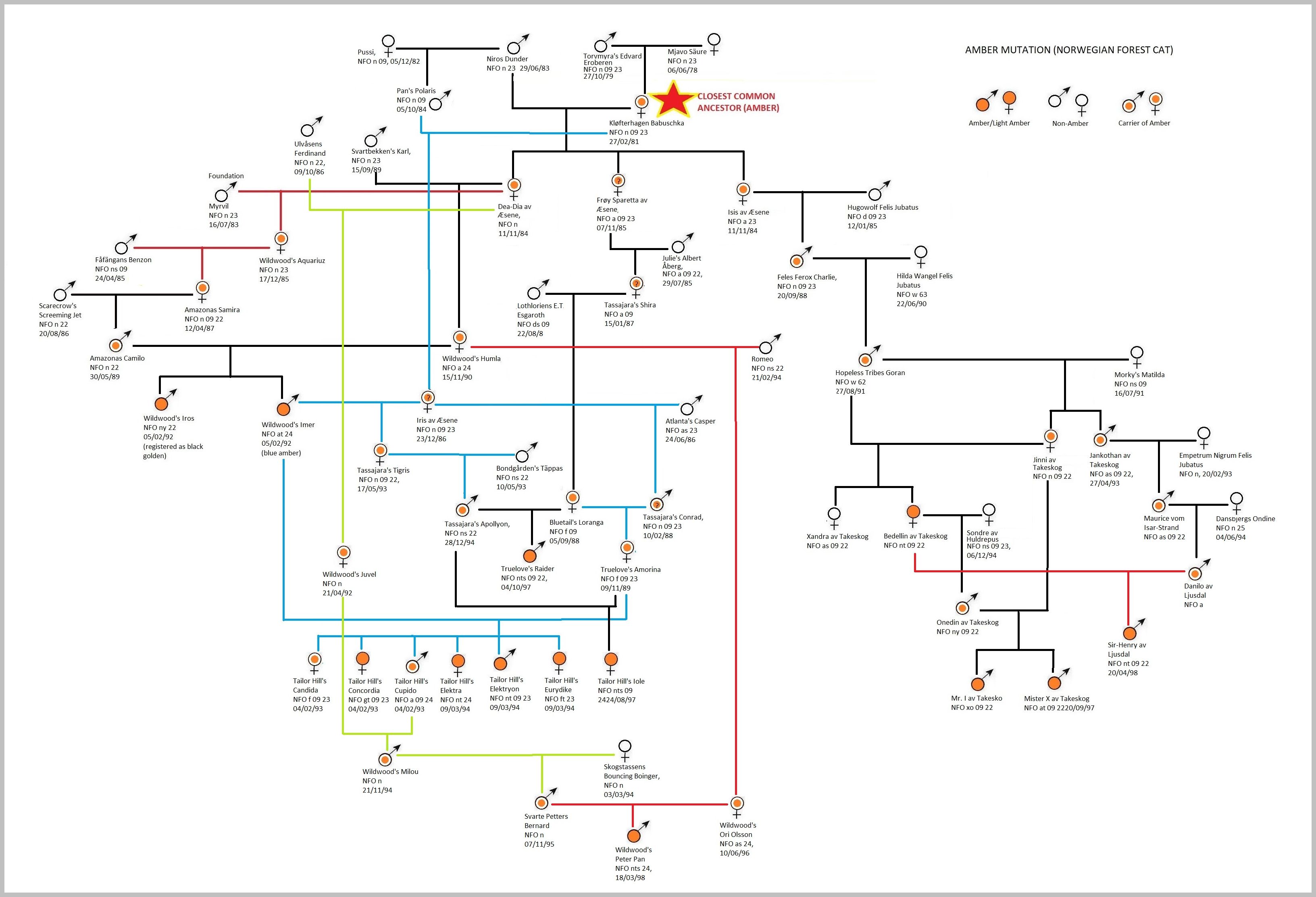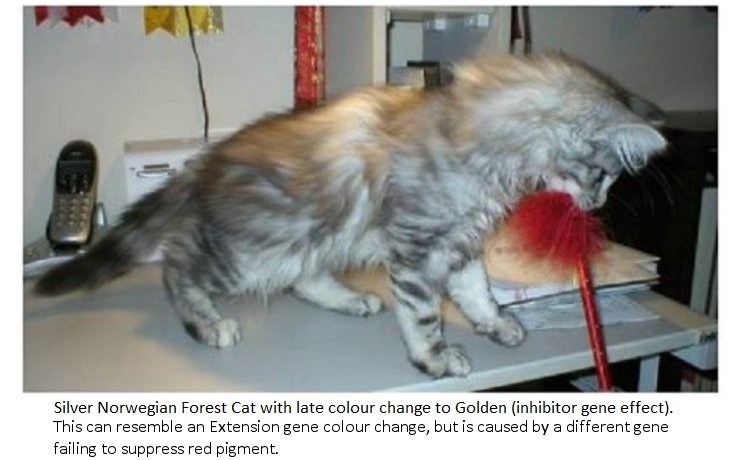
EXTENSION GENE: AMBER (NORWEGIAN FOREST CAT)
The ancestors of the domestic cat were nondescript black/brown striped tabbies. Over the centuries, mutation produced a wide array of colours based on 2 different pigments. Eumelanin gives the blacks, browns and blues while phaeomelanin gives the reds, fawns and creams. A few other genes give further variations on those colours such silvers, colourpoints and solids/selfs. Mutations continue to occur and unexpected colours also turn up due to inbreeding where recessive genes, hidden for generations, start showing up.
Amber causes the coat colour to change from a black or blue colour to a reddish or golden colour as the cat matures. Amber replaces the birth colour. Kittens are not born amber. Recently a number of Siberians and Kurilian Bobtains have been wrongly registered as amber. These may be a separate mutation called "sunshine" found only in those 2 breeds. Amber can occur in solid or tabby-pattern cats.
AMBER AND LIGHT AMBER
A late colour change gene that produces a reddish/golden hue is found in Norwegian Forest Cats. Depending on when reports were written, this gene has different names: Black Modifier, X-colour, Fox and finally Amber. After much controversy, and accusations of secret cross-breeding, Amber was identified as an Extension gene mutation.
Amber brightens black or blue areas of the coat to an apricot-to-cinnamon colour (Amber) or pale beige (Light Amber, in cats with blue dilution). At birth, kittens appeared to be black or blue, and lightened to Amber or Light Amber respectively. Amber also occurred in conjunction with silver: the kittens were born as poorly coloured black-silver or blue-silver tabbies whose tabby ghost-markings faded as they matured and their colour became a bright apricot to cinnamon colour with dark brown paw pads and nose leather with no black rim (the black rim is characteristic of silvers). Their original birth colour could be seen only on the back and tail.

During the 1990s, some purebred Norwegian Forest Cats in Sweden produced chocolate/lilac and cinnamon/fawn offspring. However, those colours are not found in the purebred Norwegian Forest Cat gene pool. Had the gene pool become polluted by someone, perhaps generations ago, breeding their Norwegian Forest Cat to another breed? Was it a spontaneous mutation? Crossing of those cats with known chocolate and cinnamon colour cats of other breeds ruled out chocolate/lilac and cinnamon/fawn genes. These cats were a totally new colour, peculiar to the Norwegian Forest Cat gene pool. It was referred to as "X Colour" because the EMS coding system uses "x" for unknown or unrecognised colours. They were eventually recognised as Amber and its dilute form as Light Amber. The Amber effect is due to the extension gene (also called red factor) which controls the production of red and black pigment. The dominant version of the gene produces normal black pigment in the coat while the recessive version produces red pigment. The name "extension gene" is because the unmutated version of the gene allows the black pigment to extend from the skin into the hair. The mutated form does not allow black pigment to extend into the hair, so the skin is black, but the hairs are reddish.
A non-agouti amber Norwegian forest Cat resembles a silver tabby, but has a distinctive black nose and black paw-pads instead of the pink/reddish nose with black outlining found on conventional silver tabbies. The photo below shows a non-agouti amber. According to Rui Pacheco, although this cat is clearly non-agouti because of the black nose, he has the phenotype of a silver shaded. Rui's theory is that the amber gene invalidates the action on the non-agouti gene; wide-banding will further lighten the base colour giving a very pale cat with black nose and paws. Amber cats are basically black cats with a colour modifier that affects the deposition of pigment on the hair shaft, but not the skin colour. That is why in non-agouti cats the nose remains black and in agouti cats it remains pink.
EMERGENCE OF THE AMBER GENE
In 1992, two unusual colour Norwegian Forest Cat kittens were born in the Wildwood's cattery in Sweden: S*Wildwood's Imer and his brother S*Wildwood‘s Iros. In 1994 the same unusual colours appeared in Germany, with D*Bedellin av Takeskog. The closest common ancestor was N*Klofterhagens Babuschka. It isn't possible to trace the "X colour" beyond Babuschka.
Breeders initially thought the X-colours (the EMS system's code for unknown colours) were chocolate (and dilute lilac) but soon referred to them as cinnamon (and dilute fawn), but cinnamon and fawn were not recognised in the Norwegian Forest Cat breed in FIFe and were even seen as a sign of impurity in the bloodline. In 1998 an attempt to approve the colours failed because breeders thought the colours were due to crossbreeding to cats where cinnamon and fawn existed. If so, crossbreeding could also introduce genetic diseases into the Norwegian Forest Cat breed. But more and more X-colour cats appeared, and carriers were identified in catteries in Europe, especially in Germany and the Netherlands.
The best known X-colour exports were S*Porfyrgardens Yeni, S*Royal Imp's Maurice, S*Royal Imp's Tinne, S*Tailor Hill's Kastor, S*Tailor Hill's Kassiopeia and S*Wildwood's Peter Pan. Some breeders embraced the colours, others condemned them.
Test-matings in the Swedish Kattbossens cattery, the German vom Arlesbrunnen cattery and the Dutch van Moraja cattery proved that the X-Colour cats were genetically black (one visible diagnostic was that they had black paw pads) and not chocolate or cinnamon. As a result, FIFe recognised the colours in 2005 and named the colour amber. By then, the gene had spread so that amber tabbies, amber solids, amber dilutes (light amber), amber silver/smoke and amber tortoiseshell existed. Ort to put it simply, any pattern that had black or blue could become amber or light amber when the mutation was present.
S*Tailor Hill's Cupido (b. 1993) was first registered as a blue tabby but was a strange colour. His father S*Wildwood's Imer and his sister S*Tailor Hill's Concordia were both amber tabby cats. Cupido was probably the first "light amber" non-agouti Norwegian Forest Cat. S*Tailor Hill's Dione (b. 1993) was the first amber tortie cat (non-agouti).

MECHANISM OF THE AMBER MUTATION
There are two different pigments in cats:
Eumelanin (the black based colours) and phaeomelanin (in "golden tabbies," rufism and red-based colours). Some out-dated texts refer to a third pigment called "trichochrome," but this is a component part of phaeomelanin, not a separate colour. All amber cats are genetically black. They have black skin, but a yellowish coat. Light amber cats are genetically blue (dilute of black).
Prior to the emergence of amber there had never been any scientific evidence of a yellow recessive mutation (e) in the extension gene in cats. The Melanocortin 1 Receptor in the DNA from 12 amber, three carriers, two wild-type NFCs, one wild-type European Shorthair and two 'golden' Siberian cats was analysed. This identified the mutation that produced the amber colour. It was only present in the amber cat lineages. Researchers concluded that the amber colour in Norwegian Forest Cats was caused by a single MC1R allele called "e," previously undocumented in cats.
The Extension gene contributes to the Melanocortin 1 Receptor (MC1R) protein pathway. MCR1 is necessary for producing eumelanin. If the MCR1 receptor is damaged (mutation) it can't make eumelanin and makes phaeomelanin (yellow) instead. The Agouti allele also allows phaeomelanin production in black-based cats even if the MC1R receptor is undamaged; that's why agouti black-based cats have a yellowish background and dark markings while non-agouti black-based cats only produce eumelanin and are solid colour. Because of this, non-agouti amber (solid amber) shows a faint tabby pattern. Some show a strong ghost tabby pattern such as the non-agouti amber kittens born to non-agouti amber-carrier parents Sannafjallet's Kaxe (black bicolour) and N* Tingoskattens Gisela (blue self) in 2008.
The unmutated version of MC1R allows the black pigment to extend from the skin into the hair (hence "extension" gene). The mutated MC1R does not allow black pigment to extend into the hair, so the skin is black, but the hairs are reddish.
REFERENCES AND FURTHER READING
- PETERSCHMITT M., GRAIN F., ARNAUD B., DELEAGE G. et LAMBERT V., (2009). Mutation in the melanocortin 1 receptor is associated with amber colour in the Norwegian Forest Cat. Animal Genetics., Vol(40), no.4, pp. 547-552.
- PETERSCHMITT M., UTESCHENY C., BALDA M., (2009). Norwegian Forest Cats in Amber – The Show Must Go On (report produced for French registry LOOF)
AMBER-LIKE COLOUR IN SIBERIAN AND KURILIAN CATS
Recently a number of Siberians and Kurilian Bobtains were wrongly registered as "amber" but are now known to have different mutations. There is a golden-type colour found in Siberian cats called "sunshine" and a dominant extension gene mutation in Kurilian Bobtails called "copal"/"carnelian." The amber-like colour seen in these breeds has pink, rather than black, nose leather and paw-pads. Brown (black) tabby copal/carnelian Kurilians are born with reddish tones and eventually become red tabby adults ("false reds") with black tail tips. Mis-identification of these cats as "amber" (EMS code "nt") causes confusion. These cats are born to golden tabby parents (EMS code "ny"). This causes the misconception that ny + ny (black-golden + black-golden) gives nt (amber). This is incorrect because "ny" is due to the agouti gene and wideband effect, but "nt" is caused by the extension gene. There is also the misconception that "ny" + "ns" (black-golden + black-silver) gives bimetallic. Bimetallic appears linked to the "sunshine" gene.
COLOUR CHANGE IN SILVER CATS RESEMBLING AMBER

This Norwegian Forest Cat was bred by Yve Hamilton Bruce from a silver mackerel tabby female (imported from Denmark) and a classic red tabby and white male. The result was 1 silver tabbies and 2 silver tabbies with white. At just over 3 months old, this silver and white tabby male developed a large patch of bright red hair on his back (as shown) which continued to spread until he was completely golden. Though similar to an amber colour-change, this is an unusual silver-to-golden change related to the inhibitor gene. Though it superficially resembles amber, this particular colour change is related to the inhibitor gene.